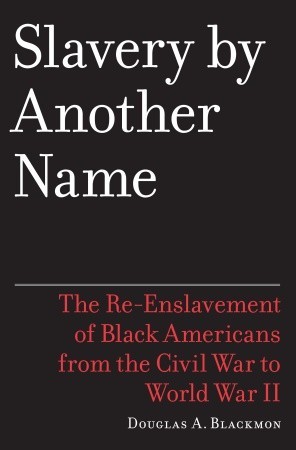
Slavery by Another Name: The Re-Enslavement of Black Americans from the Civil War to World War II by Douglas A. Blackmon (2008)
Recommendation: High
Blurb:
In this groundbreaking historical exposé, Douglas A. Blackmon brings to light one of the most shameful chapters in American history—an “Age of Neoslavery” that thrived from the aftermath of the Civil War through the dawn of World War II.
Under laws enacted specifically to intimidate blacks, tens of thousands of African Americans were arbitrarily arrested, hit with outrageous fines, and charged for the costs of their own arrests. With no means to pay these ostensible “debts,” prisoners were sold as forced laborers to coal mines, lumber camps, brickyards, railroads, quarries, and farm plantations. Thousands of other African Americans were simply seized by southern landowners and compelled into years of involuntary servitude. Government officials leased falsely imprisoned blacks to small-town entrepreneurs, provincial farmers, and dozens of corporations—including U.S. Steel—looking for cheap and abundant labor. Armies of “free” black men labored without compensation, were repeatedly bought and sold, and were forced through beatings and physical torture to do the bidding of white masters for decades after the official abolition of American slavery.
The neoslavery system exploited legal loopholes and federal policies that discouraged prosecution of whites for continuing to hold black workers against their wills. As it poured millions of dollars into southern government treasuries, the new slavery also became a key instrument in the terrorization of African Americans seeking full participation in the U.S. political system.
Based on a vast record of original documents and personal narratives, Slavery by Another Name unearths the lost stories of slaves and their descendants who journeyed into freedom after the Emancipation Proclamation and then back into the shadow of involuntary servitude. It also reveals the stories of those who fought unsuccessfully against the re-emergence of human labor trafficking, the modern companies that profited most from neoslavery, and the system’s final demise in the 1940s, partly due to fears of enemy propaganda about American racial abuse at the beginning of World War II.
Slavery by Another Name is a moving, sobering account of a little-known crime against African Americans, and the insidious legacy of racism that reverberates today.
Bo’s Review:
All men are created equal…but what if we don’t treat some of them as human?
What an eye-opening book. Did you know that slavery continued for nearly 100 years after the Civil War and the Emancipation Proclamation? Wait, let me rephrase that (because I know human trafficking still continues today in many ways).
Did you know that the systematic, legal enslavement of African Americans in the United States continued for nearly 100 years after the Civil War and the Emancipation Proclamation?
With well-documented histories, Douglas Blackmon paints a horrifying picture of life in the post-Civil War south, from slavery in lumber camps to cotton farms to coal mines. From the white on white crime right after the Civil War, often attributed to recently freed slaves, to the explicit laws that Congress had to pass in 1951 because it was still going on.
Why aren’t we taught this in history class?
It was a much-too-common story. A black man would be walking down the street. The local sheriff or deputy would stop him, make up some crime he had committed (often vagrancy or petty theft) – and heaven forbid he might resist arrest – put him in jail and charge him with fake fines. A wonderful angel of a company would come in and save this poor man by paying his fines for him. On the condition that he would sign a contract that he would work off his debt for a year. In conditions that were even worse than the horrible lives the slaves had to live pre-Civil War. And the companies would find reasons to keep these men for years and years.
I won’t go into the horrifying things that happened to these men – please read this book and find out for yourself.
Some days (now 150 years after the Emancipation Proclamation) it seems like we’ve come a long way from a time where a black man dining in the White House with the POTUS was an outrage (October 1902) to a time where an African American can actually become president. But some days it seems like we haven’t progressed much at all (check out The New Jim Crow for more on this).
Blackmon writes:
The destruction of slavery in the Civil War…made more transparent the fundamental question of whether blacks and whites could ever cohabit peacefully – of whether American whites in any region could recognize African Americans as humans.
and
…in 1896…most agreed that elimination of slavery per se was an adequate remedy to the past abuses of blacks. In the eyes of the vast majority of white Americans, the refusal of the southern states to fully free or enfranchise former slaves and their descendants was not an issue of any further disruption to the stability of the United States.
No one seemed to have much of an issue of whether or not these horrible crimes would continue to be committed.
“[By 1903] The South had nothing to be ashamed of anymore. The myth that the war had been fought over regional patriotism rather than slavery became rooted in American identity.”
And so it goes…
It boggles the mind that this continued through the 1920s, even after African Americans fought for the United States in World War I.
In the 30’s, tens of thousands of black men were still enslaved in this way.
Finally, at the brink of war, in 1941, faced with the prospect of sending thousands of African Americans to fight for their country, the U.S. government finally decided to get involved. If our government did that, then enemies of the U.S. couldn’t state that our democracy claiming all men were equal was a farce. (This is interesting – seeing as I just watched the second episode of the HBO series Watchmen, and, in it, the Germans were dropping propaganda on black American troops suggesting Germany was doing a better job of equality – at least for people of color.)
But Congress still had to pass explicit laws in 50’s to stop these practices!
If nothing else, this book will give you an even greater hatred of racism, a disgust which will, with any luck, stick with you for the rest of your days, nauseating you at any sign of oppression and hate against anyone who is weaker, marginalized, or unprivileged.
And it makes you look twice at so many things that happen today. For example, today’s desire for vouchers so that people don’t have to pay taxes for public schools smacks of the white voting in post-Civil War South to direct white taxes to white schools and black taxes to black schools.
Blackmon also notes that, “…no one who reads this book can wonder as to the origins, depth, and visceral foundation of so many African Americans’ fundamental mistrust of our judicial process.” You cannot disagree with this statement after reading this book.
Blackmon is a compelling writer. While it is obvious that Blackmon lets some opinion bleed into his writing (sometimes it’s more than “just the facts”), it’s warranted in such subject matter involving such heinous crimes – and does nothing to take away from the factuality of the material being discussed.
Read this book that focuses on such an important and hidden part of our history as an American people.
